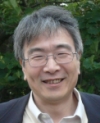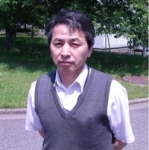Director's Corner
12 July 2007
Akira Yamamoto: A man of calm and expressions
Today's issue features a Director's Corner from Mitsuaki Nozaki, GDE Asian Regional Director.
“He is an active person who enjoys mountain climbing and jogging as hobbies. Well, at least he used to in the past. Now his hobby is physics,” Akira Yamamoto’s colleagues say. Newly appointed as one of three ILC project managers, Akira Yamamoto is a scientist working at KEK specialising in superconducting magnet development. He is highly respected among scientists all over the world.
It has been 20 years since I first started working with Akira. He always strongly impressed me as being an excellent and bold researcher who faces up to new challenges and, and at the same time, as being a highly capable engineer who elaborates detailed designs. This first impression has never changed. On the contrary, it has become much stronger.
At that time, 20 years ago, I worked at Kobe University, investigating the anomalous excess of the cosmic ray antiproton flux through the BESS detector (the Balloon-borne Experiment with a Superconducting Spectrometer), in the team of Shuji Orito, Tokyo University. Compared to the electron-positron collision experiments I was devoted to before, BESS was a whole new world for me. The memories of hard days and nights, repeating trials and errors so many times, still remain fresh in my mind.
BESS was a unique joint project between U.S. and Japanese scientists. A huge balloon carried the experimental apparatus to high altitudes to detect antimatter in cosmic radiation. The central detection device was an ultra-thin magnetic spectrometer used to identify all electrically charged particles crossing its main detection aperture. Technologies developed through high energy physics R&D, for example superconducting and particle detection technologies, were used in the BESS instruments. The BESS project in Japan was under the leadership of Akira.
Akira was in charge of numerous tasks including the design and production of the solenoidal thin-wall superconducting magnet, which was used in the BESS spectrometer. He also managed the tough negotiations with NASA (who launched the balloon), the complicated logistic coordination with Canada, and the launch site. Controlling the timeline was a particularly critical job, since the launch window of the BESS instrument was open only for a couple of weeks due to meteorological conditions. Therefore if we had missed it, we would have had to wait another whole year. With Akira's strong leadership, carrying out every production and preparation task on time, the Japanese BESS experiments succeeded, identifying the 2000 low-energy antiprotons in a kinetic energy range between 180 MeV and 4.2 GeV. Also, a characteristic peak of the antiproton spectrum around 2 GeV was clearly measured.
Akira's accomplishments in high-field superconducting magnets are of a wide variety, ranging between high-energy accelerators and particle experiments, the thin and large-scale spectrometer for BESS (whose magnet made its way to DESY). His most recent accomplishment came when he joined the LHC project at CERN. He designed and managed the quadrupole magnets for the LHC's final focus with an international team from KEK, Fermilab and CERN. A large solenoid magnet at the heart of ATLAS detector was also designed by him. The two-Tesla magnetic field generated by his thin and large magnet will help measurements of the particle tracks in curvature by the inner trackers.
Despite his quiet, down-to-earth appearance, he is a very resolute man with devotion and passion for physics. Marc Ross, who will be part of the ILC project management team with Akira, says “He is the man who makes the point. He wants to make everything clear. That makes him a great project manager.” I am also sure that Akira's strong background in project management will be a great help for the ILC community, especially to follow the technical timeline.
When he comes up against a difficult situation, he doesn't shout. Instead, he is known for a particular expression on his face that actually forces the team members to work harder, making them feel pressed to get overcome the problems. It might take some time for other collaborators to become familiar with this work style. Nevertheless, let's keep working hard and hope not to see him make this famous face!
-- Mitsuaki Nozaki


